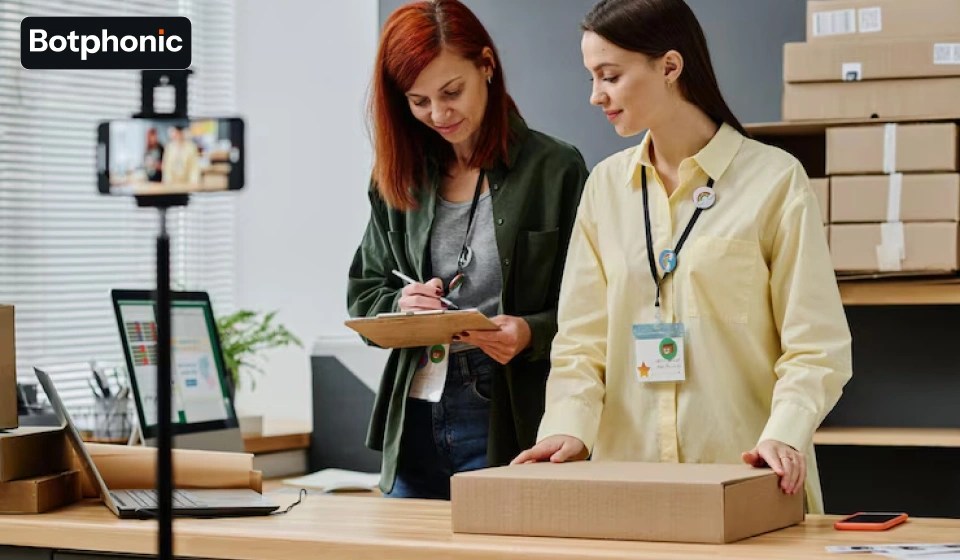
Summarize Content With:
Summary
In this blog, we have discussed how self-service can revolutionise the customer experience by providing them with faster, more innovative, and more efficient support. This guide outlines everything you need to know about the subject, including real-world benefits, best practices, and industry use cases to help you get started.
Introduction
We’ve all been there, you need help, but you’re stuck in a never-ending phone queue, listening to robotic messages, pressing buttons, and waiting in the hope that someone will answer the call. You just needed some acknowledgement or were hoping to have a prompt reply.
Sound familiar? In a 21st-century world where things happen at the speed of lightning, such a time lag seems regressive and quite an inconvenience. Customer today expect immediate responses with no hold time and fewer back-and-forth emails. That is precisely where self-service automation comes in, turning everything around.
Self-service automation is not all that convenient; it is all about being in control. It enables you to be self-sufficient in performing all routine activities, seeking assistance, scheduling appointments, or finding a solution to a technical problem without needing third-party assistance. It’s calling in and talking to an AI voice agent rather than waiting on hold or driving to a store to seek self-help.
In any case, whatever you need, self-service automation is a more innovative and faster way to get it on time. It is a win-win solution for both businesses and customers, constructed around the way we live and work nowadays.
What is Self-Service Automation?
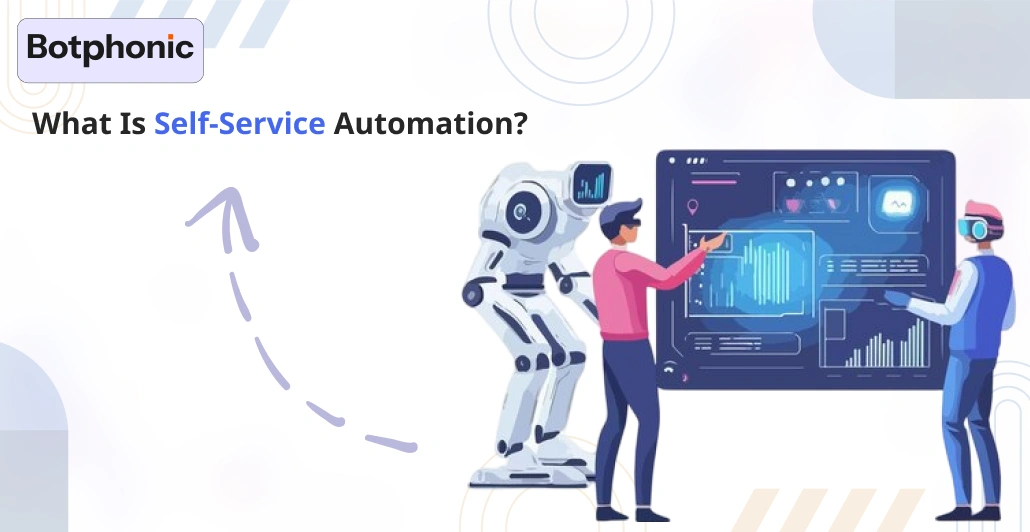
Essentially, self-service automation is a system that enables humans to resolve their issues without requiring excessive assistance from a human. Imagine it as a smart digital assistant that can always be present to answer your questions at any time of day, whether you need to know how much you owe on your internet bill or whether you can track that delivery order at coffee time.
It is an automation that incorporates the aid of technology such as voice agents powered by AI, phone receptionists powered by AI, chatbots, or a web portal that takes a user through a process. A customer does not need to call a support centre and wait on hold to receive answers, make an appointment or troubleshoot the issue, when all these procedures can be done without talking to a person.
Yet, self-service automation is not only concerned with customer support. It is speeding up ticket resolution in IT. The sales aspect involves qualifying leads before a representative enters the picture. Additionally, in processes, it assists employees in requesting or developing reports without having to go through multiple levels of approval.
Why Are Businesses Turning to Self-Service Automation?
The short answer? Because customers expect it. But there’s more to the story!
Individuals are becoming busier than ever before, and no one wants to find themselves trapped in a cycle of responding to emails, making calls, or filling out forms. Businesses can also provide 24-hour lightning-fast responses with technology such as self-service-based helpdesk automation and AI receptionists that can give customers answers without requiring them to hire enough personnel to work 24 hours a day.
This paradigm is not all about speed. It is even about power. Self-service empowers customers, allowing them to choose the time they wish to receive assistance and the mode they prefer to use. When it comes to businesses, this translates to fewer duplicated questions, more productive teams, and generally more satisfied customers.
There is also cost savings. The repetitive tasks that the system should automate imply that the support could concentrate on actual problems. They do not need to spend hours responding to questions like how to reset a password; instead, they focus on more complex problems that only a human being can solve.
Real-Life Examples You’ve Probably Experienced
- Phone a doctor in the office at night? An AI phone receptionist could help you book an appointment or leave a message for the nurse.
- Bought something online? A chatbot can help you monitor the status of your order without waiting in line.
- Are you employed in a big enterprise? You may create an IT ticket and receive an immediate response from a virtual assistant using IT self-service automation.
These are just a few instances of how self-service and automation have already become an integral part of our lives.
Key Benefits of Self-Service Automation
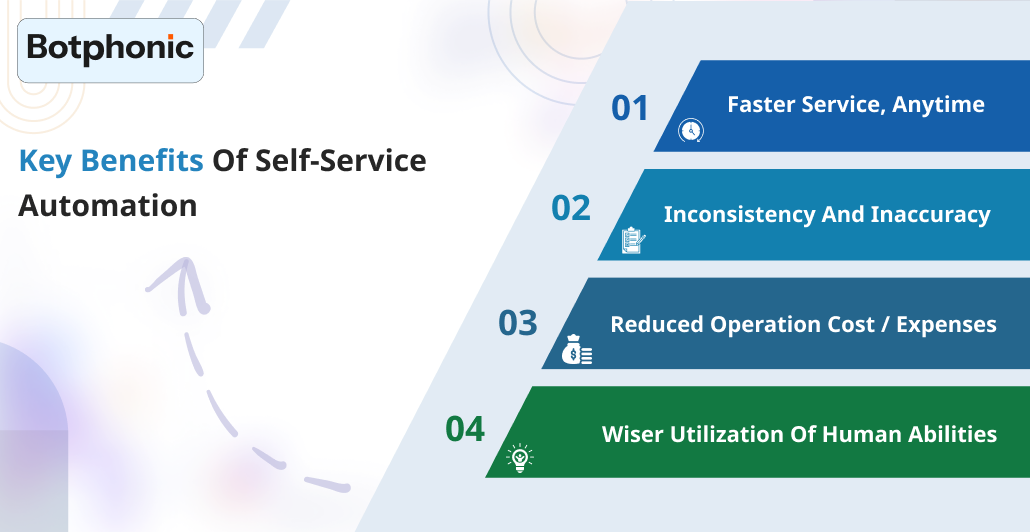
Self-service automation is shaping the modern business, particularly from the consumer’s perspective. So, what about it?
1. Faster Service, Anytime
We are living in an era where there is a lack of patience. Customers also now require promptness in the reception of answers, at their convenience. Using automation tools, it is possible to assist 24/7, even on holidays and off days.
Imagine not having a voice assistant that makes it possible to receive inquiries when the members of your team are asleep. That is not the future. That’s now.
2. Inconsistency and Inaccuracy
Human beings err. And usually, machines do not. AI voice agents are always consistent with their responses, each time. That generates trust. And after the customers trust that they are served well, they will do it again.
3. Reduced Operation Cost / Expenses
It is costly to recruit a big team to handle customer support, train, and maintain them. By automating customer self-service, you are able to work off the heavier load on your side and still deliver quality services.
Besides, automation can be scaled. Your systems will not be overloaded, whether you are attending to 10 calls or 10,000.
4. Wiser Utilization of Human abilities
The members of your team are not looking forward to hearing the same five questions throughout the day. Self-service handles the easy tasks, and your employees can concentrate on tasks that actually matter, such as solving complex problems or enhancing customer relationships.
How Self-Service Automation Works Behind the Scenes
The application of smart technologies in combination may seem like magic, but that is actually self-service automation. And here is an over-simplified view under the hood:
- With natural language processing, AI voice agents can converse with customers just as human beings do.
- Automatic systems are offered by AI phone receptionists who can schedule appointments, transfer or take messages.
- Automation in self-service reporting enables users to draw data immediately and compile a report without waiting for IT.
- Other operations made possible by the device of self-service automation include simplifying activation of passwords, installation of software, or troubleshooting transmission problems by the use of a simple chat or URL command by the employees.
All these tools are hooked to your systems, CRMs, calendars, databases, so that you can have actual action, and not just blindly provide the generic answer.
Best Practices to Get the Most from Self-Service Automation
Considering to implement self-service in your company? Here are some of the suggestions to make it work:
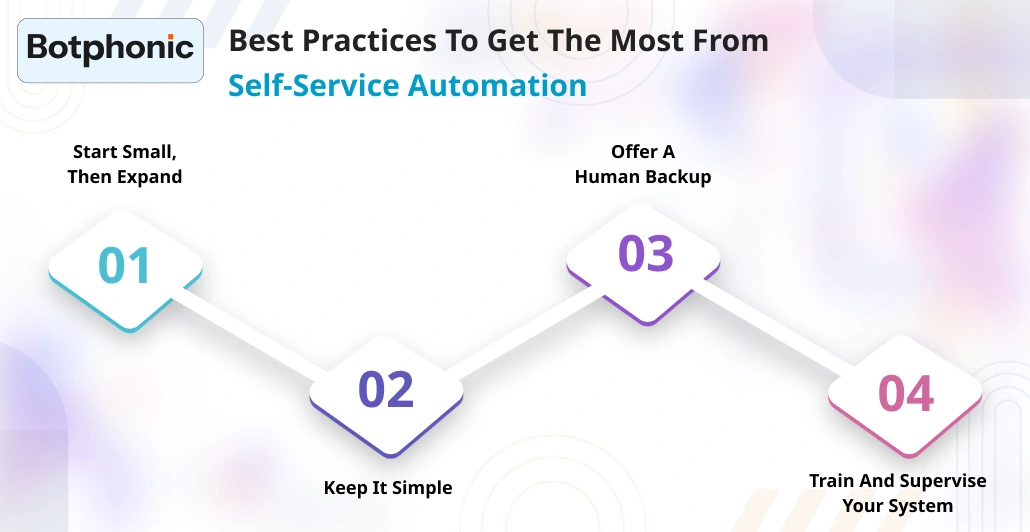
1. Start Small, Then Expand
Do not aspire to automate everything. Begin with the most redundant ones, such as answering frequently asked questions and booking rooms.
make an appointment or route a call or whatever, and then expand on that action.
2. Keep it Simple
Self-service is all about easing things. Your systems must be intuitive. When they get confused, they will still call and this will fail the intended purpose.
3. Offer a Human Backup
Somewhere along the way, automation can be very effective, yet there are times when human beings are necessary by the customer. Ensure that your system allows it to hand off to a real person, whenever necessary. This is where such a tool as Botphonic AI voice agent is brilliant; it is able to recognise frustration or a complicated problem and immediately transfer the call.
4. Train and Supervise Your System
Are you familiar with how new employees need to be trained and provided with feedback? Your AI tools should be the same. Occasionally review call logs, endeavor to make scripts and flows, so they are tight and useful.
Self-Service Automation Across Different Industries
We should have a closer look at the usage of this tech in the different sectors.
1. Healthcare
With an AI receptionist, patients can schedule their appointments, order a refill of a prescription or retrieve test results. This will reduce the number of calls thereby allowing the office workers to physically assist the patients.
2. Real Estate
They are able to book viewings, receive responses to listings, or even make applications all without awaiting a call back from potential renters or buyers.
3. E-Commerce
Order tracking, returns and FAQ on products, are assisted by chatbots and AI phone agents. This saves support teams to attend to emergency or complicated requests.
4. IT Departments
Self service IT automation is a game changer in bigger organizations. By resolving minor tech problems, employees do not have to wait on help desk personnel thus minimizing the downtimes and increasing productivity.
Common Mistakes to Avoid
The most superior technology will not be of assistance when it is applied incorrectly. These are some of the pitfalls to watch out:
- Unnecessarily complicating the flow: There is no need to make your chatbot get involved in excessive activity. Make tasks simple.
- No human backup: In case people are stuck, there must be an exit mechanism. Provide a live support possibility at all times.
- The failure to update scripts: Change of customers needs. Ensure tour system dstays up to date
- Neglect of information: Self-service sites collect vast amounts of valuable information. Discover trends and improve with them.
Self-Service Automation vs Traditional Support
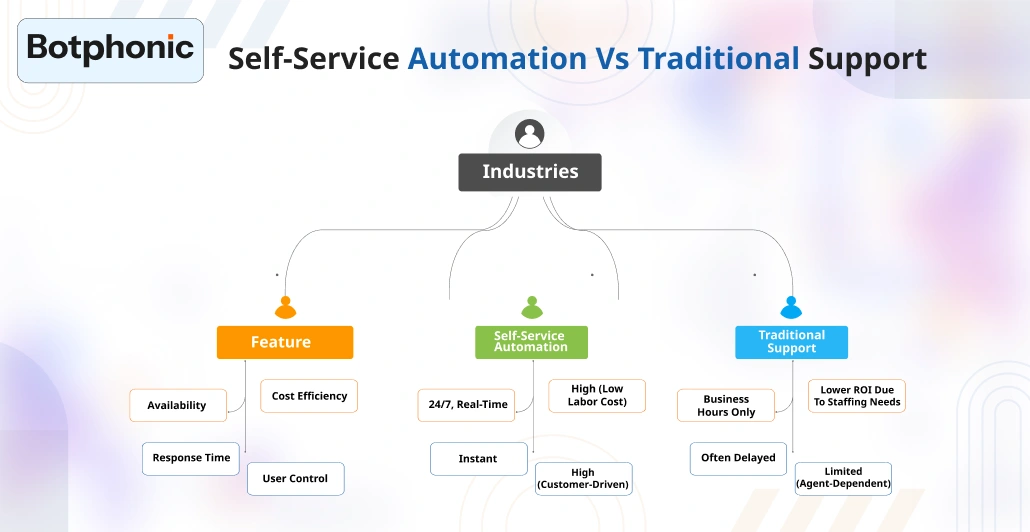
| Feature | Self-Service Automation | Traditional Support |
| Availability | 24/7, real-time | Business hours only |
| Response Time | Instant | Often delayed |
| Cost Efficiency | High (low labor cost) | Lower ROI due to staffing needs |
| User Control | High (customer-driven) | Limited (agent-dependent) |
| Scalability | Easily scales with demand | Requires hiring & training |
Is Self-Service Automation Right for You?
Whether you own a business that focuses on lots of customer contact, making and receiving lots of phone calls, customer support tickets, booking appointments, and so on, the answer is almost definitely yes.
Self-service automation no longer is a nice-to-have. It is a competitive edge. The companies using it comfortably are not only saving money, but they are also creating better, more intelligent customer journeys that their people enjoy.
Final Thoughts
Automation in self-service is not intended to replace people. It’s about serving them better, no matter who they are – your customers, getting served quicker, or your staff having more time to concentrate on valuable work.
Provided you are eager to achieve better experiences, save time as well as remain in the circle of progress, the moment you consider learning more about what self-service automation can do to benefit your business has arrived.
The service to serve what the heck, day or night, rain or shine. The thing is that, ultimately, it is not all about automation. Items empower people to do things in their aid.c

